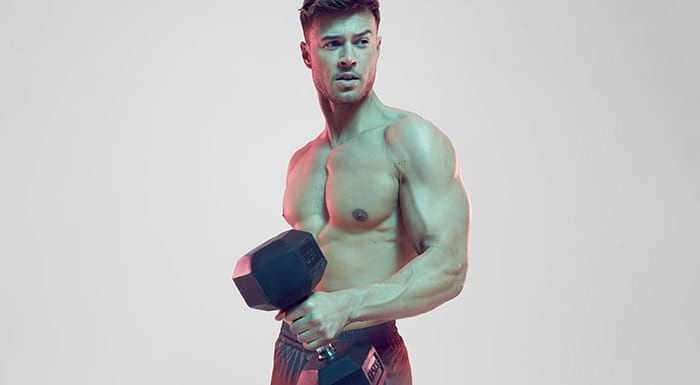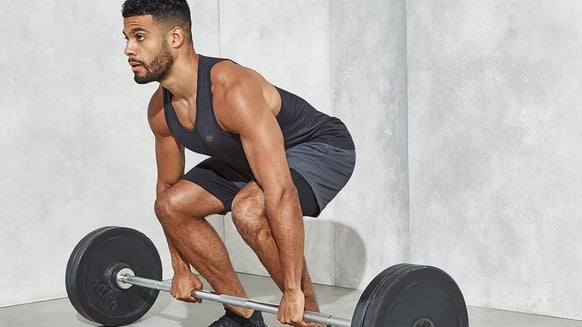Dumbbell Floor Press | Form & Benefits

At first, the dumbbell floor press may seem a poor person’s (or a lazier person’s) bench press. The shorter range of motion, lack of a bench, and lying flat on the floor doesn't exactly conjure the image of a challenging workout.
But wait, there’s more to it than meets the eye. This shorter cousin to the bench press – which actually predates the bench press as a popular workout – is a press that can benefit bodybuilders and powerlifters as both a stepping stone to developing other chest exercises as well as providing a killer tricep workout that suits those of you with shoulder injuries.
That’s right, MyProtein is here to convert you to the overlooked benefits of the simple but effective dumbbell floor press.
What is a dumbbell floor press?
Whether you realized it or not, you have probably encountered this exercise before. The dumbbell floor press looks exactly as it sounds, with the athlete lying on the floor instead of the bench with a dumbbell in each hand. While it may seem like an easier form of the press because of its restricted range of motion, it is actually shifting the brunt of the effort rather than making a lift easier.
Is it a chest exercise? Yes. But to measure it alongside the bench press you will likely overlook the fact it serves you best as a tricep isolation exercise.
It is versatile, too. Your overall workout needs to be about the bigger picture and how one exercise compliments another. Combining the dumbbell floor press with a bench or fly exercise straight will result in a hardcore session that you haven’t tried before, causing your chest to contract and your triceps to bear the brunt before you hit the bench.
Correct dumbbell floor press form
Lie down on the floor and hold two dumbbells on either side of your body. Keep your knees bent, and raise the weights by extending your arms until your elbows are locked out.
Lower the weights until your upper arms just touch the floor. As your elbows touch the floor, pause for a count of two and then push the weights up by extending your elbows. When you lower the dumbbells, make sure that your upper arms do not rest on the ground.
To tailor the floor press to a sharper tricep workout, tuck your elbows into your sides. For your chest keep your arms in an angular position to the sides in order to strengthen your chest.

What muscles does the dumbbell floor press work?
The floor press does develop the same muscles as your standard bench press because it is a pushing motion. It is the emphasis that is different. The primary muscles worked here are your triceps, with the chest a close second. Your shoulders also come into play, but the focus here is really your triceps.
Benefits of dumbbell floor press
Building muscle
You will see great results in terms of increased triceps and pectorals hypertrophy. This is best achieved with a higher rep range around the 10 – 15 mark of a heavier weight.
Building strength
Because of the shorter range, the floor press is an excellent way of building your upper body strength by allowing you to work with heavier loads, which will come ‘easier' as a result of not moving the weight as far. This is how it can benefit full range exercises. By isolating the muscles used in this partial range you will find that, in the long term, your strength will increase over this range, thus helping you when you are at that point in your bench press.
Improves your lockout
In competitive lifting and powerlifting, one of the causes of a missed lift can be a weak lockout due to elbow tension. Floor presses are good training for lockouts with heavy weights, which can help you with the likes of snatch and jerks in a competitive capacity.
Good for sore shoulders
The floor press is easier on your shoulder joints than the bench press. Good news for anyone recovering from a shoulder injury and looking for an exercise that works the triceps and chest without undue stress. It also takes your back out of the equation, meaning that your force will come from your arms and chest, as opposed to your back.

How to incorporate dumbbell floor press into your workout
The dumbbell floor press perhaps serves best as an exercise that you perform as part of a broader plan consisting of similar exercises. Combine it with tricep extensions to really build the backs of your arm.
While you won’t be able to floor press as much as you can bench, you will be able to lift far more with a floor press than you can via an overhead extension.
When building your chest it is normal to hit a plateau from time to time. We’ve all been there. You’ve been minding your nutrition, developing day by day, you’re feeling strong and then out of the blue you can’t push any further. You hit a weight that might as well be a tonne.
One of the best ways to overcome a plateau is bringing partial rep exercises into your routine. The floor press isn’t an A to B to C lift, but by including it into your chest routine you can build on the B to C part of your full lift.
The floor press is an explosive exercise whichever way you look at it. It combines heavyweight with higher frequency due to the shorter distance involved. Because the floor gets in the way, each rep basically starts from scratch. There is no opportunity to hover and take it easy. Because of this you are working at full power with each lift, making the floor press the perfect addition to an explosive strength circuit.
Take home message
The dumbbell floor press provides an explosive power and triceps-isolating exercise in its short range of movement. While from afar it may seem an easier version of the bench press it is actually a useful addition to help to improve the lockout and one rep max of your bench press.

Victoria has a master’s degree in English Literature. She loves doing unconventional workouts like pole fit, which she’s done for the past four years. She’s also a passionate foodie, so in her spare time, you’ll find her trying out the newest restaurants in her home town.









